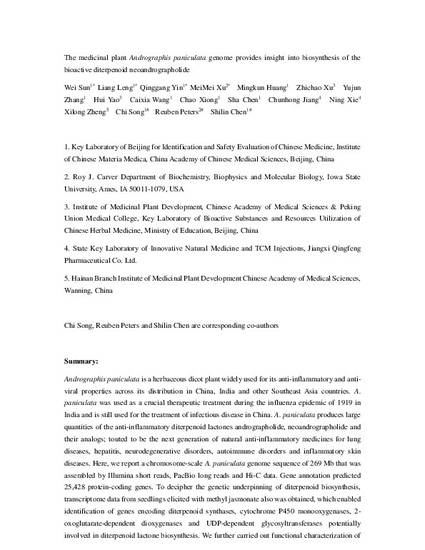
Andrographis paniculata is a herbaceous dicot plant widely used for its anti‐inflammatory and anti‐viral properties across its distribution in China, India and other Southeast Asian countries. A. paniculata was used as a crucial therapeutic treatment during the influenza epidemic of 1919 in India, and is still used for the treatment of infectious disease in China. A. paniculata produces large quantities of the anti‐inflammatory diterpenoid lactones andrographolide and neoandrographolide, and their analogs, which are touted to be the next generation of natural anti‐inflammatory medicines for lung diseases, hepatitis, neurodegenerative disorders, autoimmune disorders and inflammatory skin diseases. Here, we report a chromosome‐scale A. paniculata genome sequence of 269 Mb that was assembled by Illumina short reads, PacBio long reads and high‐confidence (Hi‐C) data. Gene annotation predicted 25 428 protein‐coding genes. In order to decipher the genetic underpinning of diterpenoid biosynthesis, transcriptome data from seedlings elicited with methyl jasmonate were also obtained, which enabled the identification of genes encoding diterpenoid synthases, cytochrome P450 monooxygenases, 2‐oxoglutarate‐dependent dioxygenases and UDP‐dependent glycosyltransferases potentially involved in diterpenoid lactone biosynthesis. We further carried out functional characterization of pairs of class‐I and ‐II diterpene synthases, revealing the ability to produce diversified labdane‐related diterpene scaffolds. In addition, a glycosyltransferase able to catalyze O‐linked glucosylation of andrograpanin, yielding the major active product neoandrographolide, was also identified. Thus, our results demonstrate the utility of the combined genomic and transcriptomic data set generated here for the investigation of the production of the bioactive diterpenoid lactone constituents of the important medicinal herb A. paniculata.
Available at: http://works.bepress.com/reuben_peters/111/

This is the peer-reviewed version of the following article: Sun, Wei, Liang Leng, Qinggang Yin, MeiMei Xu, Mingkun Huang, Zhichao Xu, Yujun Zhang, Hui Yao, Caixia Wang, Chao Xiong, Sha Chen, Chunhong Jiang, Ning Xie, Xilong Zheng, Chi Song, Reuben Peters, and Shilin Chen. "The genome of the medicinal plant Andrographis paniculata provides insight into the biosynthesis of the bioactive diterpenoid neoandrographolide." The Plant Journal 97, no. 5 (2019): 841-857, which has been published in final form at DOI: 10.1111/tpj.14162. This article may be used for non-commercial purposes in accordance with Wiley Terms and Conditions for Self-Archiving. Posted with permission.